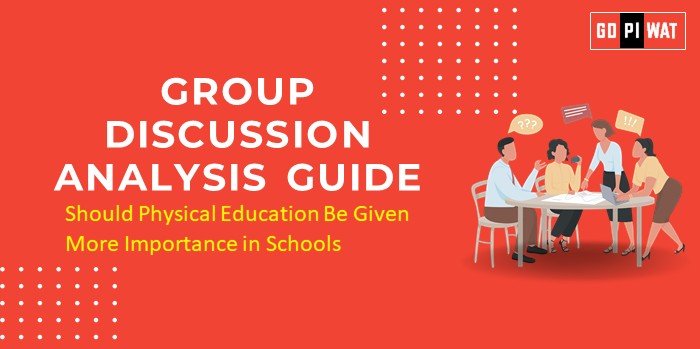📋 Group Discussion Analysis Guide: Should Physical Education Be Given More Importance in Schools?
🌐 Introduction to Physical Education in Schools
Physical education (PE) plays a vital role in the holistic development of students, encompassing physical, mental, and emotional well-being. With the growing prevalence of sedentary lifestyles among youth, schools worldwide are re-evaluating the role of PE in nurturing healthy, active citizens. For B-school candidates, this topic allows exploration of public health policies, academic balance, and long-term societal benefits.
📊 Quick Facts and Key Statistics
- 🌍 WHO Physical Activity Recommendations: 60 minutes of daily activity for ages 5–17, yet over 80% of teens globally fail to meet this target.
- ⚖️ Obesity Rates: Childhood and adolescent obesity rates have quadrupled globally over the last 40 years.
- 📈 Academic Benefits: Students engaged in regular PE tend to achieve higher grades and better attendance.
- 🧠 Mental Health Impact: Physical activity reduces symptoms of depression and anxiety, benefiting student mental well-being.
🧑🤝🧑 Stakeholders and Their Roles
- 🏛️ Government Agencies: Develop national PE policies, fund school programs, and track outcomes.
- 🏫 Schools and Educators: Implement PE programs, integrate activities into daily schedules, and engage students.
- 👪 Parents and Guardians: Encourage physical activity at home and ensure active lifestyles for children.
- ⚕️ Healthcare Community: Advocate for PE as a tool to prevent lifestyle diseases like obesity and diabetes.
- 🌐 International Organizations: The WHO and UNESCO promote global health standards and encourage school-based PE programs.
🏆 Achievements and ⚠️ Challenges
✅ Achievements
- 💡 Public Health Awareness: Campaigns have emphasized the role of PE in combating lifestyle diseases.
- 🏫 Policy Initiatives: Countries like Finland and Japan have successfully integrated PE into their educational models.
- 🤝 After-School Programs: Growing adoption of sports and physical activities through extracurricular initiatives.
⚠️ Challenges
- 💰 Resource Constraints: Limited funding for infrastructure and trained PE teachers in many schools.
- 📚 Academic Pressure: Tight school schedules prioritize core subjects over physical education.
- 🌍 Cultural and Socioeconomic Barriers: Some regions face challenges with cultural perceptions or lack of awareness about PE’s importance.
🌍 Global Comparisons
- 🇫🇮 Finland: Incorporates short activity breaks throughout the day, contributing to academic and physical well-being.
- 🇯🇵 Japan: Emphasizes “physical culture”, embedding exercise into daily routines, leading to low obesity rates.
🗣️ Structured Arguments for Discussion
- ✅ Supporting Stance: “Physical education is crucial for student health, with proven benefits for academic performance, physical fitness, and mental well-being.”
- ⚠️ Opposing Stance: “With limited school hours, the focus should remain on core academic subjects to ensure academic excellence.”
- ⚖️ Balanced Perspective: “While academic learning is essential, integrating physical education can enhance cognitive performance and overall student well-being.”
💡 Effective Discussion Approaches
- 📊 Statistics-Based Opening: “With over 80% of teens globally inactive, prioritizing PE could address rising obesity and mental health issues.”
- 🌟 Case Study Opening: “Finland’s model of integrating physical activity breaks has improved both academic outcomes and student health.”
- ⚖️ Balanced Approach: “Striking a balance between PE and academics can foster healthier and more productive students.”
🔄 Counter-Argument Handling
- 💬 Acknowledge concerns about academic pressure and highlight studies showing PE’s cognitive benefits.
- 🛠️ Suggest integrating short activity breaks into the school day to avoid disruptions to academic schedules.
- 🤝 Emphasize the importance of partnerships and government support to overcome funding challenges.
📈 Strategic Analysis: SWOT
- ✨ Strengths: Improves health, builds lifelong habits, enhances mental well-being.
- ⚠️ Weaknesses: Resource shortages, cultural barriers, and perceived disruption to academics.
- 🌟 Opportunities: Increased awareness about mental health and government funding for school infrastructure.
- ⚡ Threats: Budget constraints and lack of support from parents or local communities.
💼 Connecting with B-School Applications
- 🌍 Real-World Applications: Highlight the role of PE in developing leadership, team dynamics, and promoting a healthy work-life balance—skills vital for global business leaders.
- 🎤 Sample Interview Questions:
- “How can schools balance academics and physical education without compromising performance?”
- “What role does physical education play in fostering future leaders?”
- 💡 Insights for B-School Students: Recognizing PE’s value reflects an understanding of holistic development, which is key to managing workplace health and productivity.


